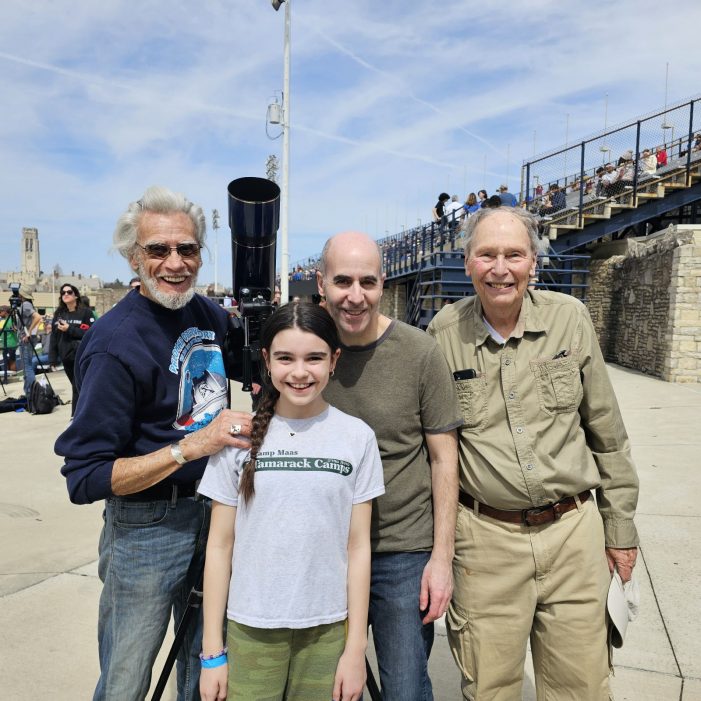(From left) Dr. Brian Kerman, Katelyn Kerman, Sean Kerman and Dr. Howard Friedman at Toledo University before viewing the total solar eclipse on April 8. Photo provided.
By Megan Kelley
Clarkston News Editor
mkelley@mihomepaper.com
For many, viewing a solar eclipse at 100% totality is a once in a lifetime opportunity but for Dr. Brian Kerman, a longtime resident of Independence Township it’s become something of a hobby.
On April 8, a solar eclipse was visible across a portion of the United States with the 100% totality path starting in Texas and moving through some parts of Arkansas, Indiana, Ohio and then up through parts of New York, Vermont and Maine.
Michigan residents were able to view the eclipse at partial totality but because of proximity, many Michiganders elected to head south for the day to Ohio, and that’s exactly what Kerman, a self identified amateur astronomer did.
Kerman traveled to Toledo University with his son Sean Kerman, granddaughter Katelyn Kerman and Sean’s father-in-law Dr. Howard Friedman.
This was the first total eclipse for Katelyn and Howard, the third for Sean and the fourth for Brian.
Kerman’s first ever total solar eclipse was decades ago in 1979 when he and his son traveled to Canada.
“It was one of the best eclipses in North America. We had to travel to Winnipeg, Manitoba. It was the Warren Astronomical Society who we were with,” Kerman said. “It was 30 degrees below zero straight. We wore snowmobile suits. It was the coldest I could ever remember being ever…we were in radio contact with Ann Arbor. We didn’t have cell phones, we didn’t have communications so we had radar that was directing us to an open area where we could view the eclipse. The University of Michigan, they knew where we were and they told the bus driver where it looked like there was an opening.”
In 1997, Kerman and his wife traveled to Aruba to see another total solar eclipse and in 2017 Kerman saw his third total solar eclipse in Wyoming.
“The one off the coast of Aruba, that one was also a rainy day in the morning but it cleared in the afternoon. It was warm. The ship was dedicated to observing the eclipse so we had hundreds of people on board with telescopes,” said Kerman.
Despite the trip to Toledo being the closest of his four journeys to view the total solar eclipse, Kerman noted that navigating I-75 added a challenge itself.
Kerman, who is a retired doctor, has always had an interest in astronomy. When he was a child, he can recall spending time drawing the sun and planets. It wasn’t until just before his first total solar eclipse that he decided to go back to school and take astronomy classes.
His decades of dedication to the science has given him a wealth of information on the topic.
“There are actually two to five total solar eclipses every year; at least two, up to five and they occur on different parts of the planet – usually over water, usually inaccessible,” Kerman said. “Over land and over America the next one here will be in 20 years. It’s a phenomenon that is really hard to talk about and explain unless you’ve seen it. Some of the facts are: it does get cold, the temperature drops about 10 degrees; it gets dark, not as dark as it gets at night but it gets dark, it gets an eerie kind of dark and it happens so quickly.”
During the eclipse, it is also the only time you can see the outermost layer of the sun’s atmosphere (the corona), Kerman said.
While Kerman has seen a number of total solar eclipses, he hopes this most recent one will solidify something of a legacy with his family.
“I told my granddaughter while we were out there that the next time she sees an eclipse in the United States she’ll have at least two children, her husband will be with her and my son, her children’s grandfather will be with her,” Kerman said. “There is a legacy there.”
Even with four total solar eclipses under his belt, Kerman’s enthusiasm for them continues to grow. He hopes to see another total solar eclipse and has his eyes on Latin America in October of this year when the next total solar eclipse is set to occur.
“It was such a great day. For something as obscure yet predictable, even though you’ve seen it before, it’s hard to explain the enthusiasm. We’re all just curious beings and seeing something so colossal off the surface of the earth – we’re so used to seeing calamities here on earth – look up a little bit more, it makes us less egocentric,” said Kerman.

